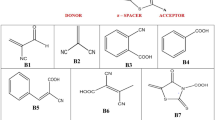Excitation energy transfer efficiency (η) of dipole–dipole interaction has been studied in the dye pair 3,3′-dimethyloxacarbocyanine iodide (DMOCI) (donor) to o-(6-diethylamino-3diethylimino-3H-xanthen-9-yl) benzoic acid (Rhodamine B, RB) (acceptor) in polyvinyl alcohol (PVA) thin films by steady-state and ps time-resolved fluorescence spectroscopy. In the presence of the acceptor the fluorescence intensity of the donor decreases, while that of the acceptor increases as a function of the added acceptor concentration. Time-resolved study of the donor at various acceptor concentrations suggest that the non-radiative energy transfer mechanism as proposed by Förster is responsible for the observed behaviour along with some modifications at very low acceptor concentrations. Modified η values have been simulated and compared with those obtained experimentally. It is found that the value of η increases with acceptor concentration.
Similar content being viewed by others
Rights and permissions
About this article
Cite this article
Tripathy, U., Bisht, P.B. & Pandey, K.K. Excitation energy transfer efficiency of dipole–dipole interaction in a dye pair in polymer medium. Res Chem Intermediat 31, 649–659 (2005). https://doi.org/10.1163/1568567054908998
Published:
Issue Date:
DOI: https://doi.org/10.1163/1568567054908998




